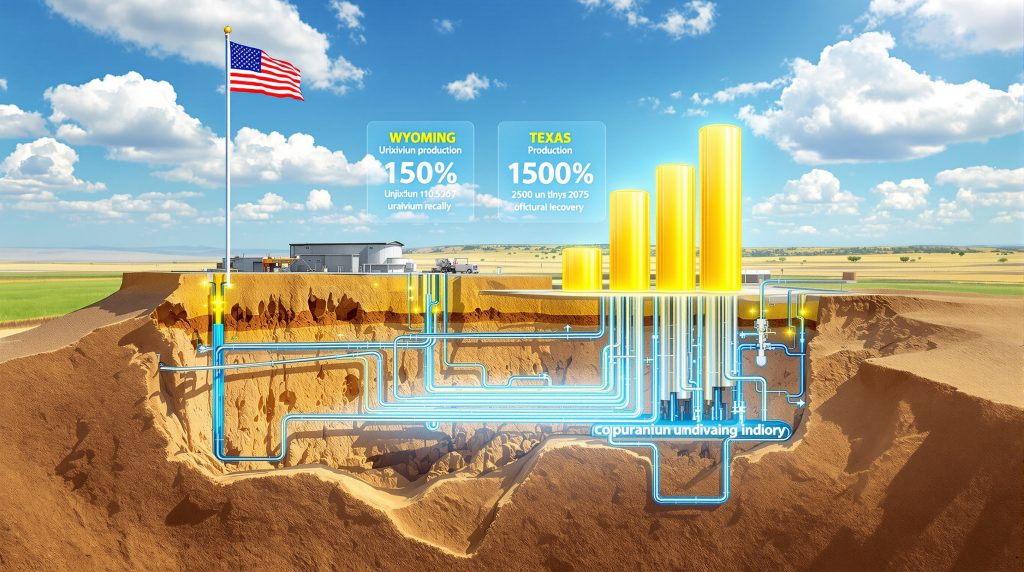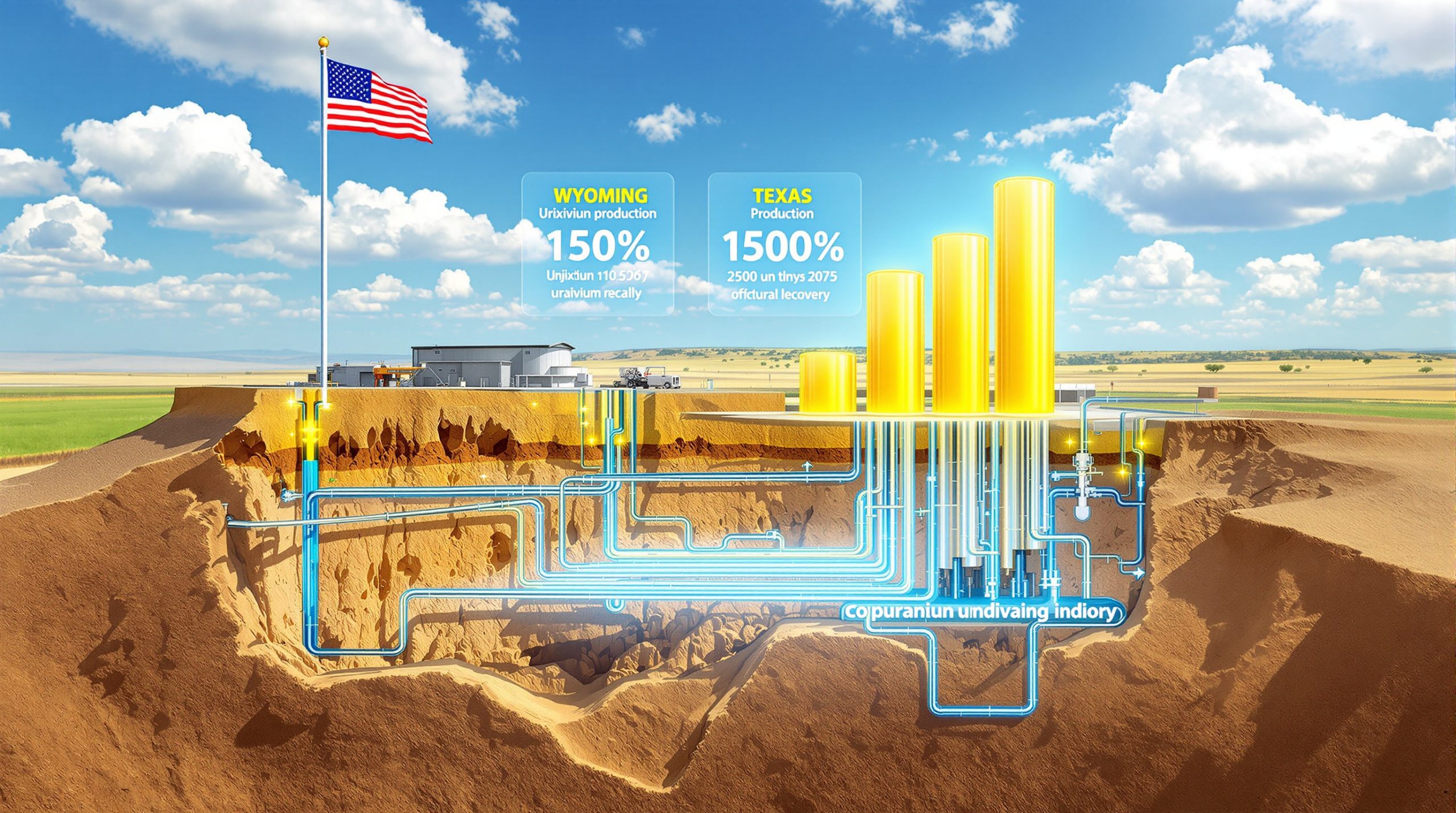In-situ recovery uranium production in the US operates through a sophisticated chemical process that transforms how the industry extracts nuclear fuel from underground formations. This technology dissolves uranium directly within subsurface ore deposits using precisely formulated chemical solutions, eliminating traditional mining excavation while maintaining exceptional recovery rates. Furthermore, understanding uranium market dynamics remains crucial for evaluating the economic viability of ISR operations.
The Chemical Process Behind In-Situ Recovery Technology
The process begins with injection wells strategically positioned throughout uranium-bearing sandstone formations. These wells introduce a specialized lixiviant solution containing water, oxidizing agents such as oxygen or hydrogen peroxide, and carbonate compounds that create optimal conditions for uranium mobilization. The solution penetrates porous rock matrices, where it oxidizes uranium from its reduced state into soluble compounds that can flow through natural permeability pathways.
Recovery wells capture this uranium-enriched fluid and pump it to surface processing facilities where ion exchange technology concentrates the dissolved uranium. Modern processing systems achieve recovery rates exceeding 90% while the treated water returns to the aquifer system, maintaining hydrological balance throughout the extraction cycle.
Lixiviant Chemistry and Formation Interaction
The chemical composition of ISR lixiviant solutions varies based on geological conditions and regulatory requirements. US operations predominantly utilise alkaline carbonate-based systems that minimise environmental impact while optimising uranium recovery efficiency. These solutions maintain pH levels between 6.5 and 8.5, creating conditions where uranium forms stable carbonate complexes that remain in solution during circulation.
Oxidising agents convert uranium from its naturally occurring reduced state (U+4) to its oxidised form (U+6), dramatically increasing solubility. In addition, the oxidation process requires careful management of injection rates, solution chemistry, and aquifer conditions to maximise uranium contact while preventing unwanted chemical reactions that could reduce recovery efficiency.
Sandstone formations provide ideal conditions for ISR operations due to their porosity, permeability, and chemical composition. The technology works most effectively in formations where uranium occurs as discrete mineral phases rather than incorporated into resistant host minerals, allowing complete dissolution and recovery.
Economic Advantages Driving ISR Adoption
In-situ recovery uranium production in the US has achieved market dominance through superior economics compared to conventional mining methods. This technology requires significantly lower capital investment, shorter development timelines, and reduced operational complexity while maintaining competitive production costs. Moreover, recent mining industry innovation has further enhanced ISR competitiveness.
Capital requirements for ISR projects typically range from $50 million to $150 million, substantially lower than underground mines requiring $200 million to $500 million or open pit operations demanding $300 million to $800 million. This capital efficiency stems from eliminated excavation equipment, simplified infrastructure needs, and streamlined processing requirements.
Development timelines further enhance ISR economic advantages. Projects can achieve production within 2-4 years compared to 5-8 years for underground mines or 6-10 years for open pit operations. Consequently, this acceleration reduces financing costs, market risk, and regulatory uncertainty while providing faster returns on invested capital.
Operational Cost Structure and Scalability
ISR uranium operations demonstrate exceptional cost scalability as production volumes increase. Fixed costs associated with processing facilities, regulatory compliance, and management infrastructure distribute across larger production bases, creating operational leverage that improves unit economics.
Recent operational data illustrates this scalability effect. EnCore Energy reduced extraction costs from $97.91 per pound in 2024 to $53.71 per pound year-to-date through Q3 2025, representing a 45% improvement driven primarily by increased throughput and operational optimisation.
The company's Q3 2025 extraction costs of $38.35 per pound against realised prices of $68.28 per pound demonstrate the margin potential available to efficient ISR operators. This cost performance positions ISR operations in the lower quartile of global uranium production costs while maintaining environmental compliance and operational flexibility.
Processing facility design enables incremental capacity expansion as market conditions warrant. However, operators can add wellfields, expand ion exchange capacity, or optimise circulation patterns without major infrastructure investments, providing strategic flexibility unavailable to conventional mining operations.
Environmental Benefits Driving Industry Adoption
Environmental stewardship represents a fundamental advantage of in-situ recovery uranium production in the US, addressing regulatory requirements and community concerns that often constrain conventional mining development. ISR operations generate minimal surface disturbance while maintaining strict groundwater protection standards throughout the mining lifecycle.
Surface impact from ISR facilities remains limited to processing plants, wellhead installations, and access roads. This minimal footprint contrasts sharply with open pit mines requiring extensive overburden removal or underground operations demanding substantial surface infrastructure for waste handling and ventilation systems.
Water management practices in ISR operations maintain aquifer integrity through closed-loop circulation systems. Furthermore, injected solutions undergo continuous monitoring and treatment, ensuring that water quality parameters remain within permitted ranges while uranium extraction proceeds efficiently.
Waste Generation and Management
ISR technology eliminates traditional mining waste streams including tailings piles, waste rock stockpiles, and overburden dumps. Processing facilities generate minimal solid waste consisting primarily of spent ion exchange resins and precipitation materials, significantly reducing long-term environmental liabilities.
Aquifer restoration represents a critical component of ISR environmental management. Following extraction completion, operators implement comprehensive restoration programmes designed to return groundwater quality to baseline conditions through continued solution circulation, treatment, and monitoring.
Regulatory frameworks governing ISR operations require extensive environmental monitoring throughout project lifecycles. These programmes include baseline establishment, operational monitoring, excursion detection, and post-mining restoration verification, ensuring environmental protection meets or exceeds regulatory standards.
Wyoming: The Heart of US ISR Operations
Wyoming dominates American uranium production through extensive in-situ recovery uranium production in the US, leveraging favourable geology, established infrastructure, and proven regulatory frameworks. The state's uranium districts have produced more than 200 million pounds historically while maintaining significant remaining resources for future development.
The Gas Hills district exemplifies Wyoming's ISR potential with recent preliminary economic assessments demonstrating exceptional project economics. Gas Hills shows projected cash operating costs of $15.51 per pound with a pre-tax internal rate of return of 54.8% at $87 per pound uranium pricing, positioning the project among the most economic uranium developments globally.
Wyoming's regulatory environment supports efficient ISR development through established permitting processes, experienced agency personnel, and clear guidelines for environmental compliance. The state's Wyoming Department of Environmental Quality maintains specialised expertise in uranium mining regulation, reducing permitting uncertainty and development timelines.
Geological Advantages and Resource Base
Wyoming's uranium-bearing formations include the Shirley Basin, Gas Hills, and Sweetwater regions, each hosting substantial resources within confined aquifer systems ideal for ISR extraction. These formations demonstrate the geological characteristics necessary for successful ISR operations: porosity, permeability, and uranium mineralisation within suitable host rocks.
Sandstone-hosted uranium deposits in Wyoming occur within well-defined aquifer systems that prevent lixiviant migration beyond designated mining zones. This geological containment reduces environmental risk while supporting efficient extraction through predictable flow patterns and uranium distribution.
The state's established infrastructure includes transportation networks, electrical systems, and skilled workforce developed through decades of energy industry activity. Consequently, this infrastructure foundation reduces development costs and operational complexity for new ISR projects while supporting existing operations.
Texas: South Texas Uranium Province Leadership
The South Texas Uranium Province represents one of North America's most significant uranium districts, hosting extensive roll-front deposits within the Catahoula and Oakville formations. These coastal plain sediments provide exceptional conditions for in-situ recovery uranium production in the US through their porosity, permeability, and favourable uranium distribution patterns.
Texas ISR operations benefit from the state's established oil and gas industry infrastructure, providing technical expertise in wellfield development, fluid handling, and subsurface operations management. This knowledge transfer accelerates ISR development while reducing technical risk through proven drilling and completion techniques.
The region's uranium deposits occur as roll-front concentrations where groundwater flow patterns have concentrated uranium into discrete, high-grade zones. These deposits demonstrate ideal characteristics for ISR extraction: well-defined boundaries, favourable host rock properties, and contained aquifer systems.
Production Capacity and Infrastructure
South Texas hosts multiple ISR processing facilities with combined annual capacity exceeding 2.8 million pounds. The Alta Mesa facility provides 1.5 million pounds of annual capacity plus 500,000 pounds from satellite ion exchange plants, while the Rosita facility contributes 800,000 pounds of additional processing capability.
Current facility utilisation rates provide significant expansion potential without major capital investment. Alta Mesa operates at approximately 60% of its configured capacity, allowing production increases through wellfield expansion and operational optimisation rather than facility construction.
The district's established production history demonstrates consistent operational performance across multiple uranium price cycles. Historical production data shows sustained extraction rates, environmental compliance, and cost competitiveness that support long-term investment confidence in South Texas ISR operations.
Regulatory Oversight and Environmental Monitoring
In-situ recovery uranium production in the US operates under comprehensive regulatory oversight designed to protect groundwater resources while enabling efficient resource extraction. The Nuclear Regulatory Commission and Agreement States maintain strict permitting requirements, monitoring protocols, and enforcement mechanisms throughout ISR project lifecycles. Additionally, US uranium import restrictions have influenced regulatory frameworks.
Aquifer exemption permits define specific mining zones where lixiviant injection will alter groundwater quality beyond drinking water standards. These exemptions require detailed hydrogeological characterisation, environmental baseline establishment, and demonstration of post-mining restoration capability before approval.
Underground injection control permits govern fluid injection practices, specifying maximum injection pressures, solution chemistry parameters, and mechanical integrity requirements for injection wells. In-situ recovery facilities ensure that ISR operations maintain aquifer containment while optimising uranium recovery efficiency.
Excursion Detection and Response Systems
ISR facilities implement sophisticated monitoring well networks surrounding active wellfields to detect any lixiviant movement beyond approved mining boundaries. These excursion detection systems measure conductivity, pH, oxidation-reduction potential, and specific ion concentrations at established monitoring points.
Excursion response protocols require immediate corrective action when monitoring parameters exceed established thresholds. Operators must demonstrate their ability to contain and remediate detected excursions through enhanced recovery, solution adjustment, or wellfield modification before receiving operational permits.
Monitoring well density typically ranges from 4-8 wells per mining unit, providing comprehensive coverage around wellfield perimeters. Real-time data transmission enables immediate response to changing conditions while regulatory reporting ensures agency oversight of environmental protection measures.
Strategic Importance of Domestic Production
In-situ recovery uranium production in the US addresses critical energy security vulnerabilities while supporting nuclear fleet operations that provide 20% of American electricity generation. The United States operates 94 commercial nuclear reactors requiring approximately 48 million pounds of uranium annually, yet domestic production contributes less than 5% of this demand.
Import dependency creates strategic risks concentrated among Russia, Kazakhstan, and Uzbekistan, which collectively supply 44% of US uranium requirements. Recent policy initiatives including the Nuclear Fuel Supply Act and Russian uranium import restrictions demonstrate government commitment to reducing foreign dependency through domestic production expansion.
Utility contracting preferences increasingly favour domestic suppliers offering supply security, regulatory compliance, and long-term delivery capability. However, this procurement shift creates demand visibility and pricing support for US-based producers while reducing exposure to geopolitical supply disruptions and US uranium production surge initiatives.
Policy Support and Market Dynamics
Federal policy support through the $1.6 billion Nuclear Fuel Supply Act provides direct funding for domestic uranium production capacity development. This legislation demonstrates government recognition that strategic uranium supply requires sustained investment and policy coordination across multiple agencies.
The September 2025 inclusion of the Dewey Burdock Project into the FAST-41 permitting framework signals accelerated federal review timelines for strategic uranium projects. FAST-41 provides coordinated interagency oversight, transparent milestones, and elevated priority that reduces permitting uncertainty while maintaining environmental protection standards.
Dewey Burdock's FAST-41 designation represents the first South Dakota ISR project to receive this status, demonstrating federal recognition of ISR technology's strategic importance for domestic uranium supply. The project's October 2024 preliminary economic assessment projects 39% pre-tax internal rate of return with $23.81 per pound cash operating costs.
Capital Investment Requirements and Competitive Economics
In-situ recovery uranium production in the US demonstrates superior capital efficiency compared to conventional mining methods across multiple economic metrics. ISR projects require substantially lower upfront investment while providing faster development timelines and reduced operational complexity.
| Mining Method | Capital Cost Range | Development Timeline | Environmental Footprint |
|---|---|---|---|
| ISR Operations | $50-150 million | 2-4 years | Minimal surface impact |
| Underground Mining | $200-500 million | 5-8 years | Significant infrastructure |
| Open Pit Mining | $300-800 million | 6-10 years | Major surface disturbance |
Capital cost advantages stem from eliminated excavation equipment, reduced infrastructure requirements, and simplified processing systems. ISR operations require injection wells, recovery wells, and ion exchange facilities rather than mining equipment, waste handling systems, and extensive surface infrastructure.
Development timeline compression provides additional economic benefits through reduced financing costs, faster cash flow generation, and decreased market risk exposure. Furthermore, ISR projects can achieve production within 2-4 years compared to 5-8 years for underground mines, enabling capital recovery acceleration and improved investment returns.
Operating Cost Advantages and Margin Expansion
ISR uranium operations typically achieve cash operating costs between $15-40 per pound, positioning these projects in the lower quartile of the global uranium cost curve. This cost advantage reflects reduced labour requirements, eliminated waste handling, and simplified processing compared to conventional mining methods.
Operational leverage creates margin expansion potential as extraction volumes increase. Fixed costs associated with facility operations, regulatory compliance, and management distribute across larger production bases, improving unit economics and cash flow generation.
Recent operational performance demonstrates this leverage effect. EnCore Energy's cost reduction from $97.91 per pound in 2024 to $53.71 per pound year-to-date through Q3 2025 illustrates the margin improvement available as ISR operations optimise throughput and operational efficiency.
Technological Innovations Advancing ISR Efficiency
Modern in-situ recovery uranium production in the US incorporates advanced technologies that optimise uranium recovery while minimising environmental impact and operational costs. These innovations enhance extraction efficiency, reduce chemical consumption, and improve environmental monitoring throughout project lifecycles.
Wellfield design optimisation utilises sophisticated geological modelling and flow simulation software to maximise uranium contact efficiency while minimising lixiviant requirements. These technologies enable precise well placement, optimal injection rates, and recovery pattern design based on subsurface conditions and uranium grade distribution.
Advanced monitoring systems provide real-time data on wellfield performance, solution chemistry, and environmental parameters. Automated control systems adjust injection rates, lixiviant composition, and recovery patterns based on changing conditions, optimising extraction efficiency while maintaining environmental compliance.
Processing Technology Improvements
Ion exchange technology has evolved to provide higher uranium recovery rates with reduced chemical consumption and improved operational reliability. Modern resin systems demonstrate enhanced selectivity for uranium while maintaining stability under varying solution conditions and extended operating cycles.
Processing automation reduces labour requirements while maintaining consistent product quality and environmental compliance. Computer-controlled systems monitor solution chemistry, adjust processing parameters, and optimise recovery efficiency continuously, reducing operational costs while improving reliability.
Water treatment technologies enable enhanced solution recycling and reduced fresh water consumption. Advanced filtration, reverse osmosis, and chemical precipitation systems recover and recycle process solutions while minimising waste generation and environmental impact.
Permitting and Regulatory Timelines
In-situ recovery uranium production in the US faces complex permitting requirements involving multiple federal and state agencies with overlapping jurisdictions. ISR project permitting typically requires 3-7 years for completion, depending on project complexity, environmental conditions, and regulatory coordination effectiveness.
Environmental impact assessments represent the most time-consuming component of ISR permitting, requiring comprehensive baseline studies, hydrogeological characterisation, and impact analysis across air quality, water resources, wildlife, and cultural resources. These studies must demonstrate that proposed operations meet environmental protection standards while providing adequate technical detail for agency review.
Public consultation processes extend permitting timelines through comment periods, public hearings, and stakeholder engagement requirements. While these processes ensure community input and transparency, they add 6-18 months to permitting schedules depending on project location and public interest levels.
FAST-41 Permitting Framework Benefits
Recent policy initiatives including the FAST-41 permitting framework aim to streamline regulatory reviews for strategic energy projects while maintaining environmental protection standards. Projects accepted into FAST-41 benefit from coordinated interagency review, transparent timelines, and elevated oversight designed to reduce permitting delays.
Dewey Burdock's September 2025 inclusion in FAST-41 represents a significant regulatory development with implications extending beyond individual project approval. The Federal Permitting Improvement Steering Council's acceptance demonstrates federal recognition of ISR uranium's strategic importance for domestic energy security.
FAST-41 designation provides accountability mechanisms for federal agencies involved in review processes while establishing clear milestones that provide investors with greater visibility into permitting completion timelines. This coordination reduces regulatory uncertainty while maintaining thorough environmental review standards.
Global ISR Implementation and US Competitive Position
In-situ recovery uranium production accounts for approximately 70% of global uranium production, with implementation varying significantly across different jurisdictions and geological settings. Kazakhstan leads global ISR production through extensive operations utilising acid-based lixiviant systems suited to local geological conditions.
International ISR operations demonstrate varying approaches to environmental regulation, operational standards, and cost management. While some jurisdictions prioritise production maximisation, US operations maintain higher environmental compliance standards that create cost premiums but also superior environmental outcomes and long-term operational sustainability.
The United States maintains technological leadership in ISR development through decades of operational experience and continuous process refinement. American operators have developed advanced monitoring systems, environmental protection protocols, and operational optimisation techniques that establish industry best practices internationally.
US Regulatory Standards and International Competitiveness
American ISR operations operate under environmental regulatory standards that often exceed international norms, creating higher compliance costs but also superior environmental protection and community acceptance. These standards include comprehensive groundwater monitoring, restoration requirements, and operational transparency that build long-term social licence while supporting sustainable operations.
US geological conditions provide significant advantages for ISR development through well-defined sandstone formations, confined aquifer systems, and favourable uranium distribution patterns. These natural advantages, combined with established infrastructure and technical expertise, position American ISR operations competitively within global uranium markets despite higher regulatory compliance costs.
Technological innovation continues to improve US ISR competitiveness through enhanced recovery efficiency, reduced environmental impact, and optimised operational performance. For instance, advanced monitoring systems, automated control technologies, and improved processing techniques maintain American leadership in ISR technology development and application.
Future Production Expansion and Technology Evolution
In-situ recovery uranium production in the US stands positioned for significant expansion driven by energy security priorities, environmental advantages, and economic competitiveness. Multiple ISR projects across Wyoming, Texas, South Dakota, and other western states await permitting approval or development funding that could double current domestic uranium production capacity within the next decade.
Production capacity estimates suggest that approved and planned ISR projects could contribute 15-25 million pounds of annual uranium production once fully developed. This expansion would substantially reduce US import dependency while providing utilities with domestic supply options that enhance energy security and procurement flexibility.
Geographic distribution of ISR-suitable uranium deposits provides operational diversification that reduces project-specific risks while supporting sustained production growth. Wyoming, Texas, South Dakota, Utah, and other states host uranium resources amenable to ISR extraction, enabling portfolio approaches that balance geological, regulatory, and market risks.
Technology Innovation and Process Optimisation
Ongoing research focuses on improving ISR recovery efficiency while reducing environmental impact and expanding the technology's applicability to different geological settings. Advanced monitoring systems incorporate remote sensing, real-time chemistry analysis, and predictive modelling that optimise extraction while preventing environmental excursions.
Lixiviant formulation research explores enhanced uranium recovery through improved oxidant selection, pH optimisation, and selective chemistry that increases recovery rates while reducing chemical consumption. These developments could improve project economics while reducing environmental impact throughout extraction cycles.
Digital technologies including artificial intelligence, machine learning, and automated control systems offer potential for operational optimisation that reduces costs while improving environmental performance. These technologies enable predictive maintenance, optimal well placement, and real-time process adjustment that maximise efficiency while maintaining compliance standards.
Integration with renewable energy systems for facility power supply represents an emerging trend that could reduce operational costs while improving environmental profiles. Solar and wind power systems can provide reliable electricity for ISR processing facilities while reducing carbon footprint and operating expenses.
Policy Support and Market Development
Federal policy support through the Nuclear Fuel Supply Act, import restrictions on foreign uranium, and energy security initiatives creates favourable conditions for ISR uranium development. Government backing provides demand visibility, financing support, and regulatory coordination that accelerates project development while reducing investment risk.
Utility contracting preferences for domestic suppliers create market demand that supports project financing and development decisions. Long-term contracts with American utilities provide cash flow predictability while reducing exposure to international uranium price volatility and supply chain disruption. Additionally, uranium investment strategies continue to evolve with these market dynamics.
The convergence of policy support, technological advancement, and market demand positions in-situ recovery uranium production in the US as a cornerstone of America's nuclear energy future. ISR technology provides the technical foundation for achieving domestic uranium supply security while maintaining environmental stewardship standards that support long-term operational sustainability.
Disclaimer: This article contains forward-looking statements regarding uranium market dynamics, production forecasts, and policy developments. Actual results may vary significantly from projections due to market conditions, regulatory changes, technical challenges, and other factors beyond current analysis. Readers should conduct independent research and consider professional advice before making investment decisions related to uranium or mining securities.
Want to Stay Ahead of Major Uranium Discoveries?
Discovery Alert's proprietary Discovery IQ model identifies significant ASX mineral discoveries instantly, including breakthrough uranium finds that could reshape portfolio performance. With ISR operations driving US uranium production growth and policy support strengthening domestic supply chains, discover how major mineral discoveries have historically generated exceptional returns for early investors. Begin your 30-day free trial today to receive real-time alerts on uranium and other critical commodity discoveries before market movements begin.




